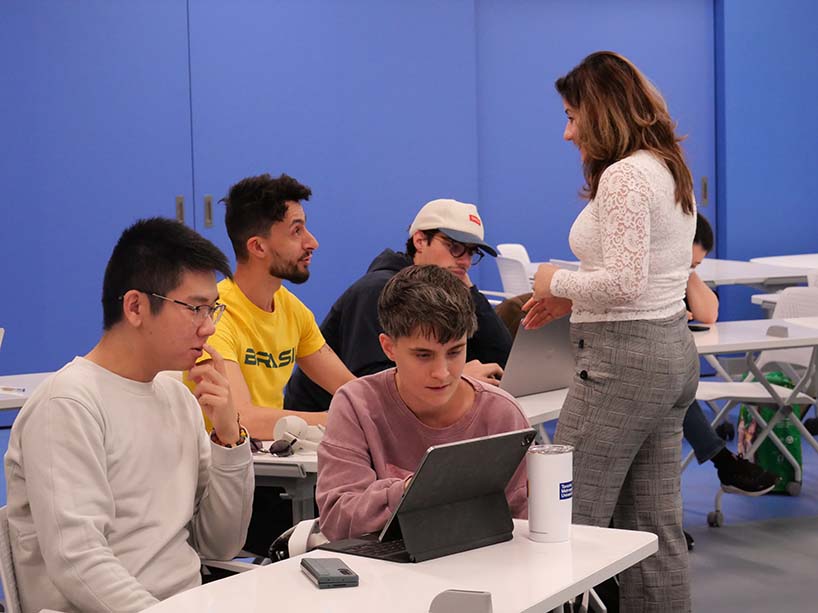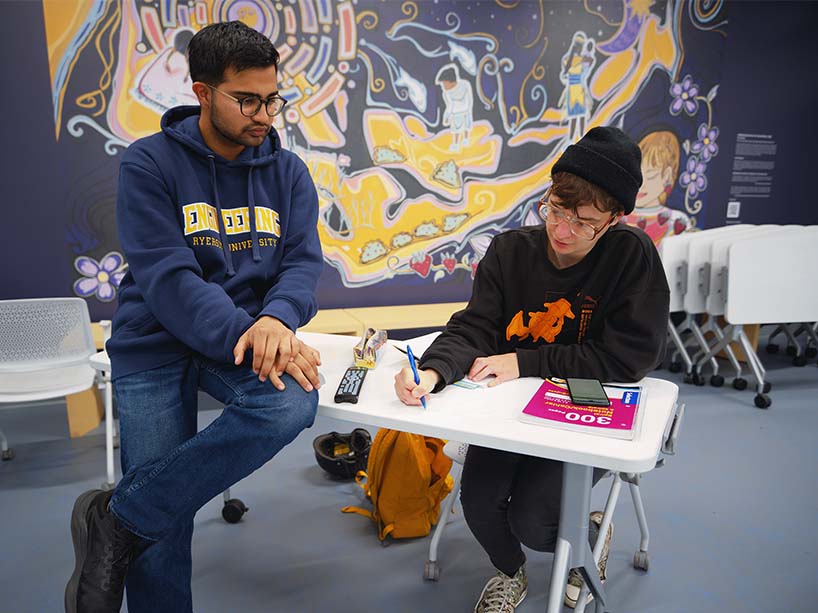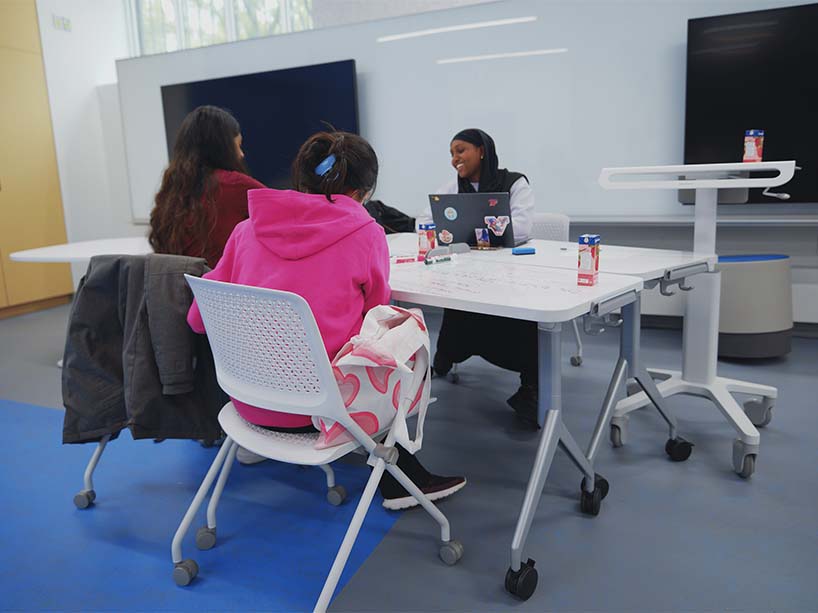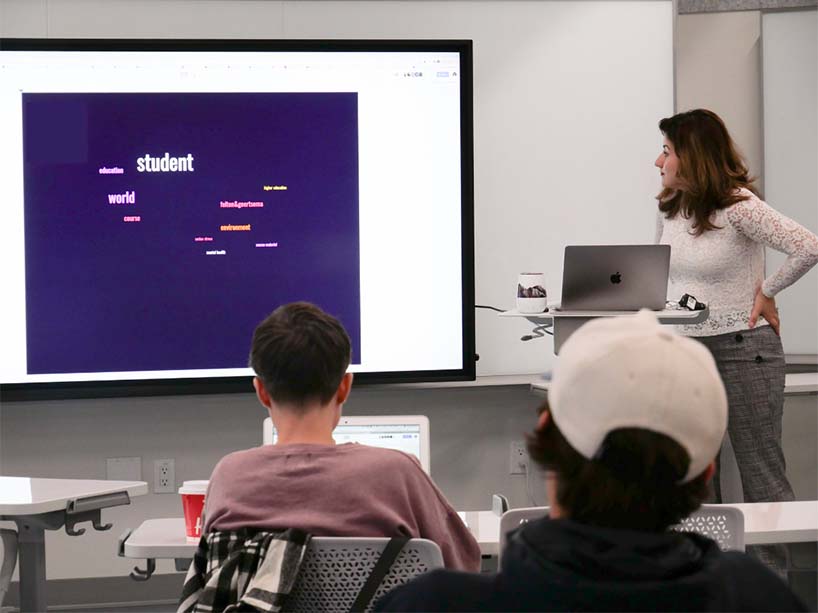A new classroom designed for active learning opens on campus

The Active Learning Classroom easily allows students to break off into smaller groups by moving the furniture themselves, fostering a collaborative environment. Photo credit: Santiago Sanz
If you venture down to Kerr Hall West 57, you will find TMU’s new Active Learning Classroom (ALC), a flexible space that includes special design features to encourage learning in a welcoming environment.
The ALC intentionally supports the well-being of all users through the use of design elements such as tunable white lighting, flexible, moveable furniture, multiple presentation surfaces and the incorporation of Indigenous art.

"Unfettered Access for Our Grandchildren," a piece by Miranda Black, TMU alumnus and Haudenosaunee visual artist, was chosen as the feature wall art to integrate Indigenous culture and history, create welcoming spaces, and bring nature inside. Take an interactive tour of the mural. Photo credit: Jonathan Cheung-Budd
“Our goal with the Active Learning Classroom is to provide a transformative teaching and learning experience,” says Dahlia Benedikt, teaching spaces coordinator at the Centre for Excellence in Learning and Teaching (CELT). “The revitalization of the classroom through innovative design upgrades is intended to fully support an inclusive,accessible, and active learning environment.”
The space is open to faculty, contract lecturers and staff to book for course-based teaching or special events. The deadline to book for courses or programming in the winter semester is Monday, Nov. 6 at 9:00 a.m.
“It’s a lot closer to the future workplace,” says Okke Schlüter, visiting professor from Stuttgart Media University. “The Active Learning Classroom is similar to an office or innovation hub, giving students insight into what it will be like working in industry.”
Schlüter taught eBooks and Publishing in the ALC over the summer, an elective course under the Graphic Communications Management program at The Creative School. Students were tasked with implementing and evaluating a prototype, and then presenting their feedback. With the classroom’s flexibility and design features, Schlüter’s students were able to easily rearrange furniture to form small groups and choose their preferred media platform for working, with some students using the presentation surfaces, and others going analog and using the buddy boards. The classroom allows students the control in setting up their learning environment.

Each table comes with two dry-erase buddy boards that can be removed and used by students to take notes or share ideas with their group. Photo credit: Jonathan Cheung-Budd
Overall, the intent of the classroom is to create positive spaces for learners and to improve learning outcomes through collaborative learning, engaging with faculty and academic challenge. It also presents an opportunity for educators to experiment with active learning pedagogy, and incorporate interactive components to their curriculum.
The ALC was born out of a pilot project in 2021, spearheaded by the Teaching and Learning Space Working Group (TLSWG), who set funding priorities for the design, creation, upgrade and maintenance of teaching and learning spaces on campus and the equipment within them.
For Sadia Rahmani and Daryll Wilson, the ALC has been the perfect space to help teach the next generation of educators how to design and incorporate active learning into their own teaching styles. Rahmani, an educational developer within CELT, and Wilson, a graduate educational developer and TMU graduate student, are co-instructors for the Learning and Teaching in Higher Education course that is part of the Graduate Teaching Development Program.

Students participate in a study session in the new Active Learning Classroom. Photo credit: Jonathan Cheung-Budd
“The ALC literally embodies everything we’re teaching our learners,” says Rahmani. “We cover topics like how to use and implement active learning, design and deliver lesson plans to students, and how to incorporate equity, diversity, inclusion and accessibility principles into education, and the space allows them to see and experience these lessons in action while they’re learning it.”
Wilson says that the classroom also challenges instructors to rethink how to deliver course material and fosters creativity in a way that can breathe new life into a curriculum.
For example, the classroom doesn't have a traditional front of class. A/V screens are installed along nearly every wall, giving instructors a choice about where to present information.
“There is a guide available for the classroom, which includes ideas for different layouts and activities that you can incorporate,” says Wilson. “We ended up using one of the suggested layouts for a gallery walk activity, which worked out really well and proved to be an effective learning tool—one of many.”

The presentation screens on each wall can be used by both instructors and students to share presentations or activities. Pictured here is a student sharing her work with the rest of the class. Photo credit: Santiago Sanz
Aside from courses, the ALC is also available to host events, workshops and other programming. Student Life and Learning Support uses the space to run a drop-in science help centre. Cleopatra Myers, Peer Learning Support Facilitator, oversees the Supported Learning Groups (SLGs) program and works with a team of 16 upper-year student staff to offer mentorship and study support services to first-year science students.
The SLGs are designed to offer peer-to-peer mentorship, covering a variety of first-year courses including math, biology, chemistry and physics. The space allows for multiple study sessions to run simultaneously.
“After years of virtual learning, it’s so wonderful to see students be able to connect with each other and find a sense of community through our study sessions in the Active Learning Classroom,” says Myers. “We’ve noticed some students who have attended previous sessions bring their friends, which is a great sign of how conducive it is to student learning.”
Curious about the Active Learning Classroom? Take a virtual tour or book an (google form) in-person tour (external link) to see the space and learn about its features. To book the space for course-based teaching or special events during the winter semester, (google form) complete and submit the request form (external link) by Monday, Nov. 6 at 9:00 a.m.





